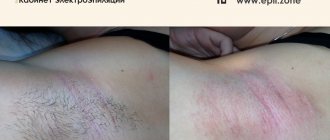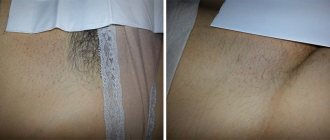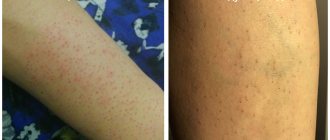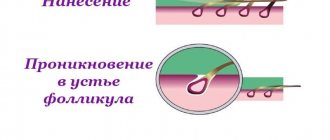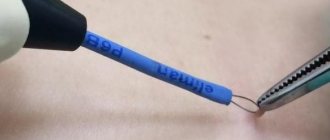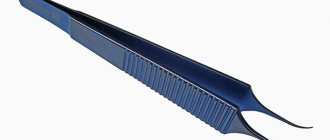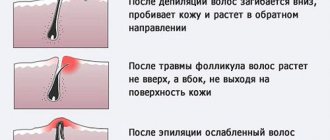The first attempts to get rid of unwanted hair on the body were made in ancient times, back in Ancient Egypt. Even then, women began to notice that excess hair creates the impression of unkemptness and does not at all decorate the appearance. In our time, this is even more considered unacceptable. And despite the fact that recently social movements have emerged calling on women to remain natural, including refusing hair removal, most still do not like hair on their legs, arms and other places that would look much better without hair. Today there are enough methods for removing excess vegetation. Electrolysis is one of them. This is a hardware method based on the action of electric current. Women note that electrolysis is painful and, in addition, requires a significant amount of time. But at the same time, it is much more effective than other procedures.
- 2 Types of electrolysis
2.1 Features of hair removal in different areas - 2.2 Video: how an electrolysis session goes
- 5.1 Video: details about the experience of electrolysis
What is electrolysis
Electrolysis is one of the types of hardware hair removal, the uniqueness of which is that, unlike other methods, it really allows you to forget about unwanted hairs forever. Each individual hair follicle is destroyed by electric current.
Initially, this method of hair removal, which was created back in 1875, was used to treat ingrown eyelashes. But after that, it gradually began to turn into a popular cosmetic procedure. Devices that deliver an electrical impulse to the hair follicle have also improved. And now you can already see modern, convenient devices for electrolysis.
The electrolysis method is used on any part of the body and face.
Electrolysis: current is the king in hair removal
At the moment, electrolysis is recognized as the only safe method of permanent hair removal. (Two other known methods: light hair removal is recognized as a method of reducing hair growth, and x-ray hair removal is prohibited).
The first successful electrolysis session was performed by Dr. Charles Michel for the treatment of trichiasis (inward growth of eyelashes). Even then, humanity knew that hair grows from a “pulp”, the destruction of which leads to the cessation of hair growth. For these purposes, they tried to inject corbolic acid subcutaneously, hot or jagged needles - anything to scar the area of the hair papilla, but they also scarred the surface of the skin. Michel used the method of electrolysis or electrocoagulation, already known at that time, to remove eyelashes, and published his successful experience in 1875. Soon, electrolysis, or the galvanic method, began to remove hair everywhere, in hairdressing and beauty salons. In 1924, French doctor Henri Bordière proposed thermolysis, a different method that was much less painful and slower. In 1945, engineer Arthur Hinkel and electrologist Henry St. Pierre, after almost 10 years of trial and error, invented the blend method, combining the efficiency of electrolysis and the speed of thermolysis.
Hair removal during electrolysis is performed sequentially: a thin sterile disposable needle (or a personal use needle) is inserted along each hair into the hair pore to destroy the follicle's ability to divide cells. All hair can be removed - of any color and in any area, except for hair inside the nose and in the inner ear. There are no people who are insensitive to the method, but the effectiveness of the method almost entirely depends on the skill of the electrologist.
Before hair removal, December 2012
After 3 procedures, March 2013
Armpit of a girl (21 years old), before the hair removal procedure in December 1996.
She in February 2010, 12 years after the hair removal cycle.
Most common areas of removal:
- Women: bikini area, armpits, legs and thighs, arms, linea alba, around nipples and chest, fingers and toes, chin, above lip, eyebrows, cheeks and sideburns, neck, scalp hairline, facial fuzz .
- Men: tip and wings of the nose, ears, forearms, eyebrows, buttocks, upper back and torso, cheeks outside the beard, hairline, as part of the treatment of ingrown hairs.
- Transgender: at a minimum, beard, chest hair, genitals (as part of gender reassignment surgery).
The average speed of work is 5-15 hairs per minute, depending on the experience of the master and the method used. The fee is charged per minute. (You can estimate how long it will take to treat your skin.) The number of treatments depends on the following parameters:
- The area of treatment and the individual characteristics of the person determine how much hair is in the anagenesis/telogenesis stage and the duration of these stages. Only hair in the anagenesis (active growth) stage can be removed, however, this statement has opponents. Depending on the duration of the stages, procedures should be carried out every 2, 6 or 12 weeks.
- Electrologist experience. The specialist’s task is to select the electrolysis method, current parameters, thickness and direction of needle insertion so as to get into the hair follicle and produce sufficient impact to remove it. The electrologist may miss the hair papilla and niche, may overdo it with current (causing slow healing and even scarring of the skin), may ignore the structure of the hair and use an inappropriate method. The most dangerous thing is untrained electrologists who are careless about contraindications of the method, sterilization and adjustment of the device.
With proper procedure and subsequent skin care, there are virtually no risks to the skin. As a rule, the next day the redness subsides and the fact that you underwent the procedure the day before will not be noticeable to others. Very sensitive skin or excessive current parameters lead to slowly healing red crusts, scars and depigmentation. In some areas, it is impossible to avoid red crusts.
Electrolysis methods
There are three main methods of electrolysis, which differ little in the procedure, but are completely different in the physics of the processes:
- Electrolysis , or galvanic method, is hair removal due to a chemical reaction that occurs when direct current passes from the active electrode (needle) to the passive one (in the hand). The product of this reaction is sodium hydroxide, a strong alkali that destroys hair. One pulse lasts from 10 seconds.
- Thermolysis is hair removal due to coagulation of the blood vessels that feed the hair. Heat occurs at the tip of the needle as a result of the passage of alternating current. The method has several variations: flash, microflash, picoflash, multiplex. One pulse lasts a fraction of a second.
- Blend - hair removal due to a chemical reaction during the passage of direct current, accelerated by the thermal effect of alternating current at the end of the needle. One pulse lasts 4-8 seconds.
I have a separate article about each of these methods, answering the questions: how does it work? what are the problems? why and when is a method good or bad? It is best to read them sequentially: electrolysis → thermolysis → blend. In addition, there are several quack methods that mimic electrolysis - tweezer electrolysis and transdermal electrolysis.
The choice of method is critical because it determines the area of influence (see figure below). Thus, with curved follicles, thermolysis and flash may not be effective.
In this case, only the blend will have an effect on the hair.
Electrolysis tools
Sophisticated models of devices for electrolysis do not differ in hair removal efficiency from devices 20-30 years ago or cheap electroepilators in the price range of up to $1000. The difference is that modern devices have more standard hair removal programs depending on the type of hair and the depth of its bulb. Such programs create less unpleasant sensations by reducing the exposure time and replacing one long impulse with a series of short ones. Most expensive devices have built-in final skin care programs that help relieve swelling, constrict blood vessels, restore skin pH (cataphoresis, anaphoresis, iontophoresis); these programs are sometimes implemented using a separate device. Some devices have a voltage sensor (by which you can indirectly judge whether the needle has entered the follicle: there is a lot of fluid around the anagen follicle, which is a better conductor than the dermis) or allow you to independently adjust the time and current strength - flexible settings in skillful hands can have advantages, but also the cost of mistakes is higher.
Below are photographs of devices from different years and countries of manufacture:
Electric epilator Chemi-Therm. There are thermolysis and electrolysis modes, but there is no blend yet.
Russian EHVCh-20-01-MTUSI. Thermolysis mode.
The Fischer SE5 electroepilator looks like a HF generator

